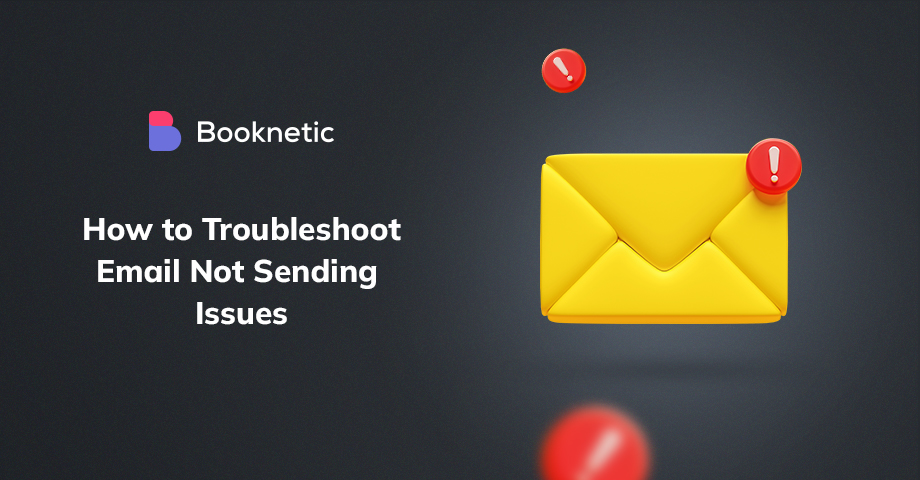
Have you ever noticed your emails not sending properly? This issue can ruin your workflow, decrease productivity and cost you important clients.
Reasons for that might be as simple as network connection problems and huge email attachments or something more complex, like incorrect SMTP authentication settings. Luckily, you might be able to troubleshoot the emails not sending problem yourself.
5 ways to solve email not sending issues
Scan the device for malware
One of the reasons why your emails don’t reach the recipient’s inbox is that the recipient blocked your IP address. Alternatively, you also need to consider the possibility that your IP address may have been added to an IP blocklist.
IP blocklisting is a method for filtering illegitimate or malicious IP addresses. If your IP address is blocked, it does not necessarily mean that you did something wrong. Instead, your Internet Service Provider could have assigned you a previously abused IP address.
It is also possible that someone might be exploiting your IP address for spying or to infect your device with malware. To do this, a hacker can hack into your network and attempt to brute-force access to your device.
If you suspect that malware might have compromised your mailing activities, check whether malicious software has compromised your device. If your device is infected, networks and websites you visit might consider your IP as potentially dangerous. Run a full scan of your computer and check if your antivirus programs and firewalls are up to date.
Ultimately, to keep your system secure, make sure your antivirus is up-to-date and consider employing VPN services. VPN can conceal your IP address and make it harder for hackers to exploit it.
Check your mail provider’s sending limits
According to Statista, 306.4 billion emails were sent and received worldwide each day in 2020, and the numbers are bound to grow even higher in the years to come. However, email sending limits exist, and email service providers impose certain limitations to maintain the productivity of the email servers and ensure security.
While you alone might not send that many emails every day, email providers still have email sending limits for both individuals and businesses that send a lot of them.
Email providers define how many emails an account can send over a given period since the server may overload and lose productivity. Furthermore, if you exceed the limit, Gmail and other mail services may suspect that you are sending spam (even when you are not) and block your IP address.
If you exceed the set limit of daily emails, you can expect to receive a message warning you about it. For example, Gmail officially limits Gmail trial accounts to 500 emails per 24 hours and 500 recipients in a single email. Luckily, you can send more emails by converting to a paid account or creating a new one.
Check SMTP authentication settings
What if anyone could send an email from your account, steal your clients and copy your original ideas? Sadly, spammers can exploit your email server to send unauthorized emails or even trick email recipients into disclosing sensitive information, such as credit card numbers.
For example, spammers can impersonate a familiar bank or another trusted source and ask for personal information. Fortunately, SMTP (Simple Mail Transfer Protocol) authentication helps the mail server identify the email user who is sending an email.
Moreover, SMTP ensures that only a legitimate user can send an email from a mail server. If SMTP is enabled, you have to provide a username and a password for the server. If the credentials are valid, the user’s mail is accepted. If the authentication fails, the mail client shows an error message.
However, an authentication failure does not necessarily mean that someone is trying to get to your email server. Check your credentials, enable your SMTP authentication or contact your email provider if your mail client does not support this type of verification. You can also try ESMTP(Enhanced Simple Mail Transfer Protocol) which adds more security features and authentication to SMTP.
Configure DNS records
Thanks to DNS (domain name system), we can use a simple website name instead of a complicated string of numbers. For example, when you type in google.com, DNS translates the IP address 142.250.80.14 to take you to the website. In addition to easier browsing, DNS records include specific configurations for email safety.
To improve email deliverability, you have to configure your public DNS records to allow other mail servers to trust you to receive your mail. For example, SPF (Sender Policy Framework) records are used for email verification.
SPF records check if an incoming email comes from an authorized IP address and filter forged emails. With SPF records, hackers should, in theory, face a bigger challenge when trying to imitate the domain. As a result, SPF can help reduce the risk of phishing attacks, spam emails and spoofing.
If you want to configure DNS records for better mailing activities, Internet Service Providers can offer DNS hosting and technical support. Some services may also provide in-depth instructions on how to create DNS records manually.
Contact email service provider
If you can’t access your email or send and receive messages, firstly check your internet connection and your email account’s credentials. If that information is valid and your connection is good, check your email provider’s website. It is possible that the provider is experiencing some issues or is under maintenance.
You can contact the provider directly to get a confirmation that everything is in order on their part. Usually, email service providers give their contact information at the bottom of their websites. Some providers also offer troubleshooting applications. For example, Outlook has a Get Help application to help you solve possible issues.
You should contact your email service provider if you can’t solve the email not sending issue yourself. A provider that has a good customer support team will always be at your service to ensure that your email runs smoothly. Without a doubt, the provider will also assist in adjusting any email settings to help you avoid any frustration.
Conclusion
It can be challenging to solve the email not sending issue that might come up due to numerous different reasons.
The most stressful and frightening of them is when someone tries to use your email server for malicious activities. However, with appropriate measures, you can prevent that from happening.
The good news is you can troubleshoot some of these email not sending issues yourself. Even if you can’t or have doubts, you can always contact your email service provider or system administrator for assistance.
Sign up for our newsletter
Be the first to know about releases and industry news and insights.
Booknetic is a simple yet powerful plugin for accepting online bookings & payments on your WordPress site.



